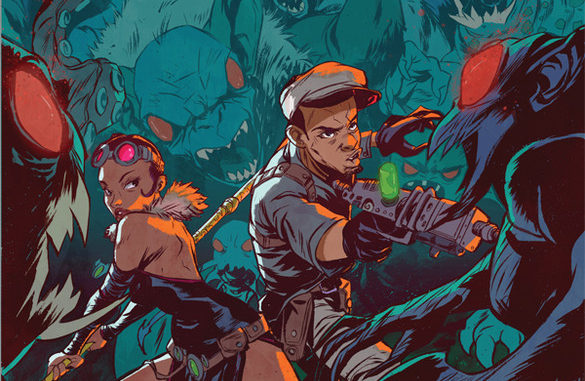
One of the best things about 2018 is the amount of new comic-books, launches of familiar worlds and long-forgotten characters getting a light shined on them. What many readers love best about comics is the way information is dispersed without interrupting the entertainment. For some the experience of entering these fictional landscapes is that in some way they are rooted in realism. In some way a connection is made. That’s what good storytelling does. The following comic-books in this year-end review have transported readers to new worlds, showed them the underbelly of familiar ones and have exposed writers to new audiences.
Bitter Root
Before you read ‘Bitter Root,’ the most recent collaboration between David F. Walker, Chuck Brown and Sanford Greene go straight to the back of each issue. In their editorial ‘Bitter Truths’ the creators break down how racism can be the center of horror and that ascribing the atrocities of humans is easier to swallow when the Devil can be the one to blame. As if some evil manifested out of a person is able to make them do horrific things. No, the big baddie is clearly explained of how it takes little to let out the monster within. A passage from Toni Morrison’s ‘Beloved’ is included as is John Jennings’ discussion of the Ethnogothic. It’s a theory which, in part explains how Black people utilize horror and the gothic genre to examine what it means to be the other in a dominant white society. And what it means to be seen as less than human in order to maintain a false status quo. At the end of the second issue Kinitra Brooks writes about root-working and the grounding it has had in Black-American culture, its erasure and the necessary steps needed to reclaim these traditions. Then Jennings appears again, this time to talk about Alain Leroy Locke and his contribution to the Harlem Renaissance. Both essays contextualize ‘Bitter Root’ and show its importance because it’s not only informative, but entertaining.
As a comic-book the first two issues released in late 2018 is about a Black-American family called Sangerye who are deeply connected to their conjuring roots. They seem to be after infected white people called Jinoo. The dialogue is crisp and the artwork is outstanding. Taking place in Harlem and Mississippi during the 1920’s issue one starts as soon as you turn the page. Immediately, as a reader you are in danger and you don’t figure out why. What’s more there’s an exceptionally, large Black man drinking out of the smallest of tea cups, with a vocabulary that will have you reaching for a dictionary. A real one, not just a quick look on the internet. You’re going to need one where each word you attempt to find has several definitions. It’s unapologetically smart with quick action and well-rounded characters. Great research is at work here.
Issue two brings more narrative complexity and gives insight to several characters introduced in the first installment of this series. It seems that the Sangeryes have enemies they have yet to know about. Both issues have arresting covers with Black characters who are drawn as if you would meet them on the street. In action poses, danger surrounds them. However, each character appears to be quite capable. Then there’s the back of each comic-book. Three gears are anchored by a set of roots. The image brings several questions. Still, as a reader you know it’s purposeful. Rarely has there been back pages with an image that moves the comic’s story. The creators have utilized the entire medium to tell a story.

Leave a Reply